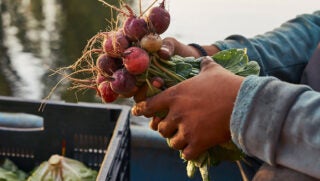This past spring was one of the wettest on record for many of us in the agriculture community. Reports of flash flooding came streaming in when Texas received over 19 inches in 24 hours — a new record for Brenham, Texas, according to The Weather Channel. From Texas to Missouri, flooding reached new heights. Many of the rains came unexpectedly and fast — so fast, that many banks were overtaken by the flood water. This had a huge impact on the agriculture industry.
Many of the floods hit during one of the worst times, when seedlings were at their most vulnerable. Farmers had to monitor oxygen depletion, and air temperatures, along with other changes to determine whether they would need to replant. Many livestock were lost due to the flood in the spring as well.

In times like these, it is essential to make informed decisions on what to do next. The decisions farmers and ranchers make now determine their profit in the future. Pivotal decisions never tend to be easy to make, but when farmers have to decide to replant 500 acres of corn due to flooding implications, it can cut into their bottom-line profit. However, when informative decisions are made, profits can still be received. So whatever the weather’s outcome was in your area, here are a few thoughts to keep in mind while making critical decisions.
1. Stay updated within your local Cooperative Extension center. Agents there keep an outlook inventory to let local farmers and ranchers know what diseases are showing up in your area , so you know what to spray for or what to be on the lookout for.
2. Go to your local FSA office. They may be able to provide assistance to ranchers who lost livestock during the flood in order to help make up the difference. The local USDA offices are around to help farmers and ranchers in many aspects of the farm, from cost sharing on cover crops to helping make ends meet.
3. Know exactly what your crop or cattle need. A knowledgeable scout can come in handy if the farmer isn’t able to make it into their field often. For example, with all the extra rain, corn roots have more shallow tendencies. A foliar application can help in order to prepare for the warm, dry weather.
4. Think about the end goal. Just because market prices are down, it doesn’t mean it is necessarily the best thing to do to cut corners on production. Decreasing input systematically decreases output and you will have less product to show for your labor. Don’t be surprised if you tried to cut back in a few crucial areas and don’t see the results you expected.
5. Keep your head up! Even when prices seem low and everything is breaking down, don’t despair. Those who have been in the agriculture industry for a while know the ups and downs of profitable years and not-so profitable ones. Previous years have resulted in good prices; it was only time before a downward slope occurred. But we know that the agriculture roller-coaster will always have its ups and downs. Just try and hold on and enjoy what you can of this crazy ride.
Images by Kacie Gaines

